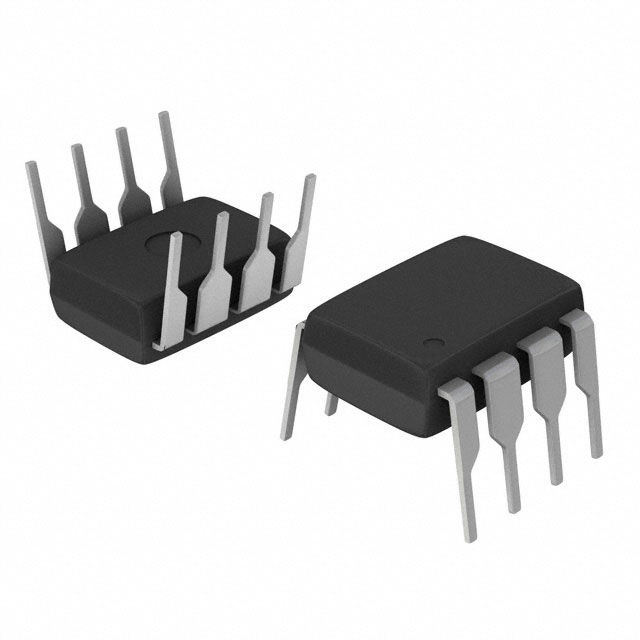Viz Specifikace pro podrobnosti o produktu.

LTC1098ACN8#PBF
Product Overview
Category
The LTC1098ACN8#PBF belongs to the category of analog-to-digital converters (ADCs).
Use
It is used for converting analog signals into digital data for processing and analysis in various electronic systems.
Characteristics
- High precision
- Low power consumption
- Small form factor
- Wide operating temperature range
Package
The LTC1098ACN8#PBF comes in an 8-pin PDIP (Plastic Dual In-line Package) format.
Essence
The essence of LTC1098ACN8#PBF lies in its ability to accurately convert analog signals into digital data with minimal power consumption and a compact package.
Packaging/Quantity
It is typically available in reels containing a quantity of 250 units.
Specifications
- Resolution: 8 bits
- Conversion Rate: 100ksps (kilo samples per second)
- Input Voltage Range: 0V to VCC
- Power Supply: 2.7V to 5.5V
- Operating Temperature Range: -40°C to 85°C
Detailed Pin Configuration
- VIN+ (Pin 1): Non-inverting Analog Input
- VIN- (Pin 2): Inverting Analog Input
- GND (Pin 3): Ground
- CS (Pin 4): Chip Select
- SCLK (Pin 5): Serial Clock Input
- SDI (Pin 6): Serial Data Input
- SDO (Pin 7): Serial Data Output
- VCC (Pin 8): Power Supply
Functional Features
- High accuracy and linearity
- Low power consumption
- Simple serial interface for communication with microcontrollers or other digital devices
- Internal reference voltage for easy integration into various systems
Advantages
- Compact package suitable for space-constrained applications
- Wide operating temperature range allows for use in harsh environments
- Low power consumption extends battery life in portable devices
- High precision ensures accurate conversion of analog signals
Disadvantages
- Limited resolution compared to higher-bit ADCs
- May require external amplification for low-level analog signals
Working Principles
The LTC1098ACN8#PBF utilizes a successive approximation register (SAR) architecture to convert analog input voltages into digital output codes. It employs an internal reference voltage and a precise comparator to achieve high accuracy and linearity in the conversion process.
Detailed Application Field Plans
The LTC1098ACN8#PBF is well-suited for various applications, including: - Portable medical devices - Industrial automation systems - Sensor interfaces - Battery-powered instruments - Data acquisition systems
Detailed and Complete Alternative Models
Some alternative models to LTC1098ACN8#PBF include: - LTC1098L - LTC1098-5 - LTC1098-10
These alternatives offer varying resolutions, speed, and power consumption to cater to different application requirements.
In conclusion, the LTC1098ACN8#PBF is a versatile and efficient analog-to-digital converter that provides high precision and low power consumption, making it suitable for a wide range of electronic systems.
Word Count: 466
Seznam 10 běžných otázek a odpovědí souvisejících s aplikací LTC1098ACN8#PBF v technických řešeních
What is the LTC1098ACN8#PBF?
- The LTC1098ACN8#PBF is a low-power, 8-channel, 8-bit analog-to-digital converter (ADC) designed for use in various technical solutions.
What is the supply voltage range for LTC1098ACN8#PBF?
- The supply voltage range for LTC1098ACN8#PBF is typically between 2.7V and 5.5V.
What is the typical power consumption of LTC1098ACN8#PBF?
- The typical power consumption of LTC1098ACN8#PBF is very low, typically around 150µA.
What is the maximum sampling rate of LTC1098ACN8#PBF?
- The maximum sampling rate of LTC1098ACN8#PBF is 100ksps (kilo-samples per second).
Can LTC1098ACN8#PBF be used in battery-powered applications?
- Yes, LTC1098ACN8#PBF's low power consumption makes it suitable for battery-powered applications.
What are the typical applications of LTC1098ACN8#PBF?
- Typical applications of LTC1098ACN8#PBF include data acquisition systems, industrial process control, and portable instrumentation.
Does LTC1098ACN8#PBF have built-in reference voltage?
- No, LTC1098ACN8#PBF requires an external reference voltage for operation.
What is the interface type for LTC1098ACN8#PBF?
- LTC1098ACN8#PBF features a simple parallel interface for easy integration into various systems.
Is LTC1098ACN8#PBF suitable for temperature sensing applications?
- Yes, LTC1098ACN8#PBF can be used for temperature sensing applications with appropriate sensor interfacing.
Are there any specific layout considerations for using LTC1098ACN8#PBF?
- It is recommended to follow the layout guidelines provided in the datasheet to ensure optimal performance and noise immunity when using LTC1098ACN8#PBF.

